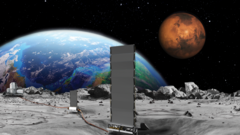NASA is propelling its plans to establish a nuclear reactor on the Moon with an eye towards achieving a sustainable human presence by 2030. This initiative comes amid intense global competition in space exploration, as countries like China and Russia also express aspirations to build permanent lunar bases. Acting NASA head Sean Duffy emphasized the imperative for rapid advancements in nuclear energy technology, citing its critical role in energy generation for potential lunar colonies and strengthening US national security in space.
While the concept of a lunar nuclear reactor is not unprecedented, the feasibility of such a project within the proposed timeframe is mired in skepticism. Recent budget cuts—amounting to a significant 24% reduction for NASA by 2026—have raised concerns among scientists and space enthusiasts. The funding cuts notably target several scientific programs, including the Mars Sample Return mission.
The challenge of sustaining energy during lunar cycles—a 14-day period of sunlight followed by a 14-day period of darkness—has led many experts to identify nuclear energy as a necessary solution. Researchers argue that solar power alone cannot meet the high energy requirements needed for advanced lunar habitats, which would demand megawatt-scale energy production.
Experts like Dr. Simeon Barber from the Open University caution that launching radioactive materials into space poses safety concerns, which adds another layer of complexity to the project. Despite these issues, specialists like Lionel Wilson believe that technological capabilities exist for placing such reactors on the Moon—pending sufficient funding and effective execution of the Artemis program, which currently aims for its first crewed lunar landing in 2027.
Underpinning the urgency of NASA’s plans is an array of international agreements, including the Artemis Accords, which aim to establish collaborative principles for Moon exploration. However, there are fears that nations may seek to claim territorial interests on the Moon, particularly if they can establish operational safety zones around their lunar installations.
As the deadline approaches, the feasibility of launching a nuclear reactor to the Moon remains contentious, with significant doubts cast on the coordination and funding needed for success. With the international space race heating up once more, the implications of these developments for the future of lunar exploration and ownership are profound.
While the concept of a lunar nuclear reactor is not unprecedented, the feasibility of such a project within the proposed timeframe is mired in skepticism. Recent budget cuts—amounting to a significant 24% reduction for NASA by 2026—have raised concerns among scientists and space enthusiasts. The funding cuts notably target several scientific programs, including the Mars Sample Return mission.
The challenge of sustaining energy during lunar cycles—a 14-day period of sunlight followed by a 14-day period of darkness—has led many experts to identify nuclear energy as a necessary solution. Researchers argue that solar power alone cannot meet the high energy requirements needed for advanced lunar habitats, which would demand megawatt-scale energy production.
Experts like Dr. Simeon Barber from the Open University caution that launching radioactive materials into space poses safety concerns, which adds another layer of complexity to the project. Despite these issues, specialists like Lionel Wilson believe that technological capabilities exist for placing such reactors on the Moon—pending sufficient funding and effective execution of the Artemis program, which currently aims for its first crewed lunar landing in 2027.
Underpinning the urgency of NASA’s plans is an array of international agreements, including the Artemis Accords, which aim to establish collaborative principles for Moon exploration. However, there are fears that nations may seek to claim territorial interests on the Moon, particularly if they can establish operational safety zones around their lunar installations.
As the deadline approaches, the feasibility of launching a nuclear reactor to the Moon remains contentious, with significant doubts cast on the coordination and funding needed for success. With the international space race heating up once more, the implications of these developments for the future of lunar exploration and ownership are profound.

















